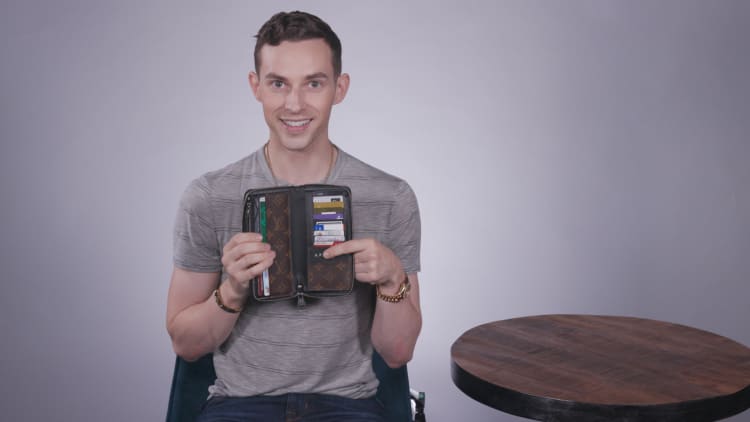Apple announced on Tuesday, August 6, that the Apple Card will be released to a random selection of people who opted into the "notify me" list that opened earlier this year.
These participants will be the first consumers to preview the much anticipated credit card that is backed by Goldman Sachs and part of Mastercard's global payment network.
In the months since the card was announced, Apple has gradually been dropping details about the card's features, including a unique cash-back program, digital-forward design and enhanced security.
Most recently, Goldman Sachs released the cardmember agreement, which provides details on how the cash-back program works and the card's rates and fees.
While Apple isn't revealing the credit score consumers need to qualify for the card, it was created with the iPhone user in mind. The tech company is using this introductory period as a test run to fine-tune the product. The card, for example, doesn't allow authorized users, but that's already something Apple is considering changing thanks to early feedback.
Below, CNBC Make It breaks down exactly how the Apple Card works — from the cash-back program to fees, fine print, privacy and security.
How the cash-back program works
The Apple Card is a primarily digital card that lives in the Wallet app on a cardholder's iPhone. Cardholders have the option to request a physical titanium card.
The Apple Card's cash-back program is tailored to the company's products, services and mobile wallet: You can earn 3% cash back on goods or services purchased directly from Apple (including Apple retail stores, the Apple online store, the App Store, iTunes, Apple Music and other Apple-owned properties), 2% cash back on Apple Pay purchases and 1% cash back on all other purchases.
Update: Since launch, Apple continues to add new merchants that offer 3% cash back when you use your Apple Card via Apple Pay. New additions include: Uber, UberEats, Walgreens and Duane Reade stores, on the Walgreens app, on walgreens.com and at T-Mobile stores.
There is no sign-up bonus for this card or rotating cash-back categories.
Cash back is referred to as "Daily Cash," and it is automatically deposited into your Apple Cash card (also located in the Wallet app) at the end of every night. Daily Cash can be used in a number of ways: applied as a statement credit to your Apple Card balance, spent like cash through Apple Pay, transferred to a bank account or sent to friends via iMessage.
If you don't have an active Apple Cash card, your cash back accrues in your Apple Card account, and you can manually redeem it through the Wallet app.
The Apple Card's benefits
The Apple Card is one of the few cards that can truly be considered "no-fee." Cardholders don't have to pay annual fees, foreign transaction fees or late payment fees, making this card beneficial for consumers who often miss payments or travel abroad.
While there are no fees, you can still rack up interest on this card if you don't pay your bill in full. There is a 12.99% to 23.99% variable APR, based on your creditworthiness, which isn't very different than competing cards on the market. Right now, the average APR for new credit cards is 16.91% and that's expected to drop some as a result of the recent Fed cuts.
The creators of Apple Card are hoping cardholders take advantage of the card's financial wellness tools that show users exactly how much it will cost if they carry a balance.
When you make a payment, there's a simulation wheel with a "payment nudge" that allows you to select a payment amount and see how much interest you'd be charged for the given payment. You can adjust the "nudge" and see what the interest would be if you made only the minimum payment or any other amount. This feature is user-friendly and represents Apple's mission to create transparency.
The Apple Card provides a detailed snapshot of your spending history in real-time. Purchases are categorized by color, and you can track your spending weekly or monthly. You can also see where and when you make purchases alongside the transaction cost.
The Apple Card's privacy and security features
Apple uses advanced security measures to protect cardholders' privacy. Every transaction you make with the digital Apple Card requires your device number and a one‑time, dynamic security code, which is authorized via Face ID or Touch ID.
Purchases made with the physical card are secured with chip technology. And, the physical card has no numbers on it — no card number, security code or expiration date — making it practically impossible for someone to steal your information when you hand your card to pay.
If an online merchant doesn't support Apple Pay and you need to enter your card number to complete a purchase, you can access that information through the Wallet app.
If you misplace your card, you have the option to freeze it and request a replacement directly from the Wallet app.
Apple states that while it won't look at your transaction data, Goldman Sachs does have access so it can operate the Apple Card, reviewing transactions for fraudulent activity, for example. However, Goldman Sachs will never share or sell your data to third parties.
Fine print
The cardmember agreement states that if you modify or "jailbreak" your iPhone, you may no longer be eligible to access or manage your Apple Card.
Don't miss: Experts aren't all impressed by Apple's new credit card, but here's why it could be a good choice for you
Like this story? Subscribe to CNBC Make It on YouTube!



